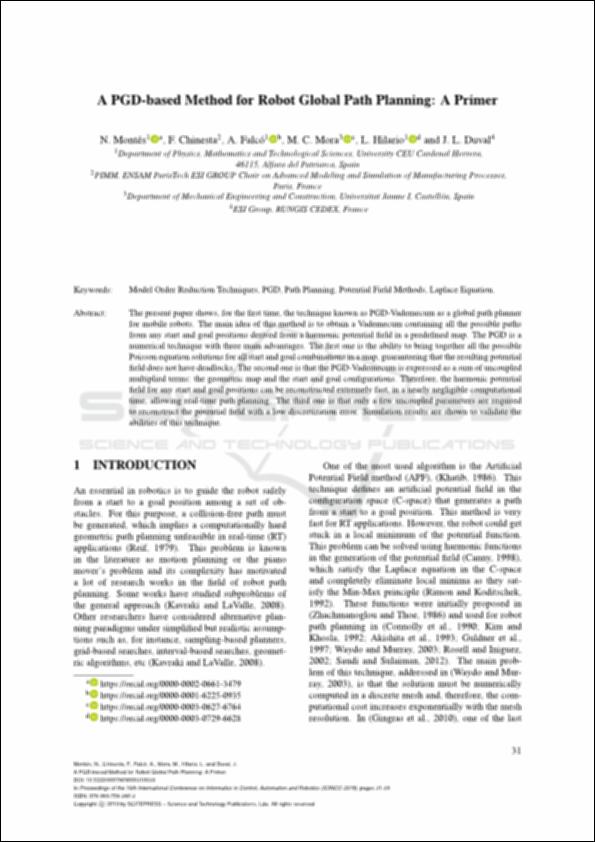Por favor, use este identificador para citar o enlazar este ítem:
http://hdl.handle.net/10637/13375A PGD-based method for robot global path planning : a primer
| Título : | A PGD-based method for robot global path planning : a primer |
| Autor : | Montés Sánchez, Nicolás Chinesta, Francisco Falcó Montesinos, Antonio Mora Aguilar, Marta Covadonga Hilario Pérez, Lucía Duval, Jean Louis |
| Materias: | Robótica - Modelos matemáticos.; Robotics - Mathematical models.; Métodos de simulación.; Machine theory.; Simulation methods.; Autómatas matemáticos, Teoria de. |
| Editorial : | Science and Technology Publications. |
| Citación : | Montés, N., Chinesta, F., Falcó, A., Mora, M., Hilario, L. and Duval, J. (2019). A PGD-based method for robot global path planning : a primer. In Proceedings of the 16th International Conference on Informatics in Control, Automation and Robotics (ICINCO 2019), pp. 31-39. DOI: https://doi.org/10.5220/0007809000310039 |
| Resumen : | The present paper shows, for the first time, the technique known as PGD-Vademecum as a global path planner for mobile robots. The main idea of this method is to obtain a Vademecum containing all the possible paths from any start and goal positions derived from a harmonic potential field in a predefined map. The PGD is a numerical technique with three main advantages. The first one is the ability to bring together all the possible Poisson equation solutions for all start and goal combinations in a map, guaranteeing that the resulting potential field does not have deadlocks. The second one is that the PGD-Vademecum is expressed as a sum of uncoupled multiplied terms: the geometric map and the start and goal configurations. Therefore, the harmonic potential field for any start and goal positions can be reconstructed extremely fast, in a nearly negligible computational time, allowing real-time path planning. The third one is that only a few uncoupled parameters are required to reconstruct the potential field with a low discretization error. Simulation results are shown to validate the abilities of this technique. |
| Descripción : | Esta comunicación se encuentra disponible en la siguiente URL: https://www.scitepress.org/Papers/2019/78090/78090.pdf Este artículo pertenece a la 16th International Conference on Informatics in Control, Automation and Robotics (ICINCO 2019) - Prague, Czech Republic, 29-31 July 2019. |
| URI : | http://hdl.handle.net/10637/13375 |
| Derechos: | http://creativecommons.org/licenses/by-nc-nd/4.0/deed.es |
| ISBN : | 978-989-758-380-3 |
| ISSN : | 2184-2809 |
| Fecha de publicación : | 29-jul-2019 |
| Centro : | Universidad Cardenal Herrera-CEU |
| Aparece en las colecciones: | Dpto. Matemáticas, Física y Ciencias Tecnológicas |
Los ítems de DSpace están protegidos por copyright, con todos los derechos reservados, a menos que se indique lo contrario.


